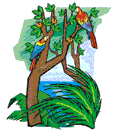Life in the Deciduous Forest Biome
A lesson and worksheet on life in the deciduous forest biome.
Objectives:
• Students will be able to describe the climate and characteristics of the deciduous forest biome.
• Students will be able to state where deciduous forests are located.
• Students will be able to name animals that are native to deciduous forests.
• Students will be able to name the five zones of deciduous forests as well as name the types of plants that grow in each zone.
Suggested Grades:
4th Grade - 5th Grade - 6th Grade
Print the reading comprehension worksheet passage and questions (see below).
Students should read the passage silently, then answer the questions. Teachers may also use the text as part of a classroom lesson plan.
Lesson Excerpt:
If you live in an area where leaves change color in autumn, you probably live in or near a deciduous forest. Deciduous trees are trees that lose their leaves once each year. Before they fall, the leaves of deciduous trees turn yellow, orange and red. The leaves then fall to the ground in winter and decay. This is good for the forest environment because the decayed leaves fertilize the soil and make it rich for growing other plants and trees.
Many areas that are now towns, suburbs and farms were once deciduous forests. In fact, at one time, most of the United States east of the Mississippi River was covered with deciduous trees. Western Europe was also once almost entirely deciduous forestland. Many animals now commonly seen in suburban towns are forest animals such as chipmunks, squirrels, raccoons and skunks. Larger animals, like black bears, deer and foxes live in the forests that still exist. In Asia, the deciduous forest is home to weasels. Birds that live among deciduous trees include cardinals, robins, crows and hawks. If you live in the suburbs, you have probably seen these species of birds in your neighborhood.
Continued...

Lesson Printables:
Print this printable worksheet for this lesson:


